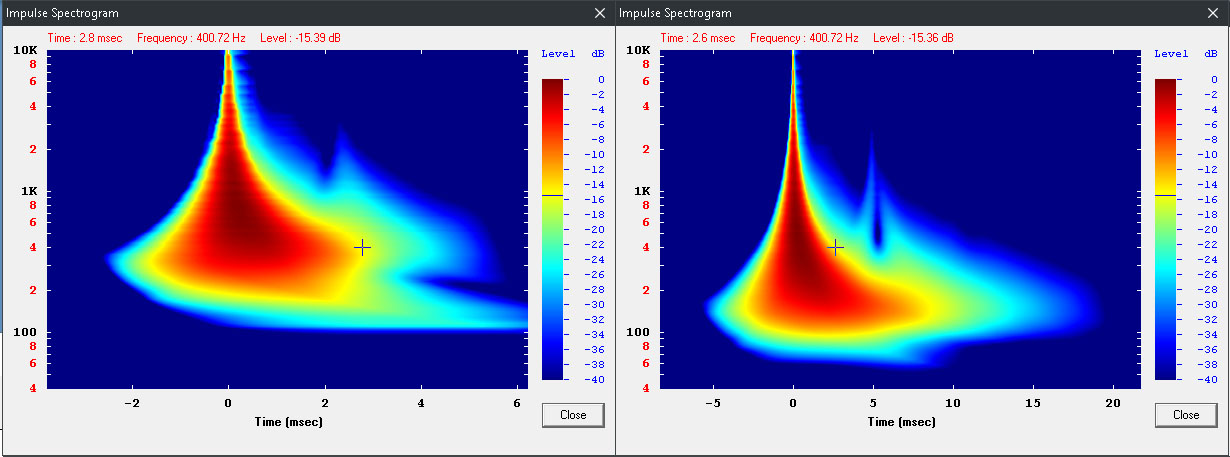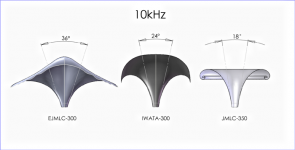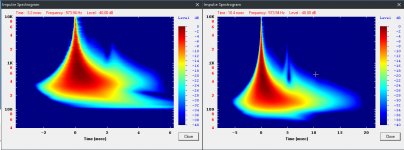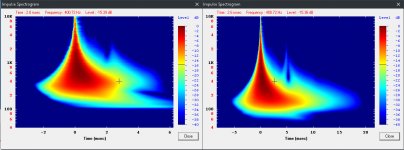Fluid - I know you are right but the room can only affect what its fed correct? A shorter decay from the driver still translates into a shorter decay in the room correct?
I think they are saying that the room adds so much decay, that decay as a topic, is a lost cause....this must apply below Schroeder only, I take it but, maybe a better way of putting it is - putting sugar on a turd, its still a turd. The room being a turd.
You sort of answered your own question
One big difference with sealed subwoofers is that they can produce much more extended low frequency output than a resonant system can. Below the tuning frequency excursion is uncontrolled unless it is filtered.That leads me to believe that the only reason people use sealed over vented is for improved group delay otherwise whats the point of losing efficiency to run sealed when you can run a BR tuned to 20hz have higher efficiency, and still within margin group delay.
Low frequency extension is one of the things that cause a speaker to be preferred in blind tests.
This is why I said these sorts of graphs are tricky to interpret correctlyMy first question would of been why doesn't the decay graph line up with CSD wavelet....
My second question would of been why doesn't my HR spectrogram line up with REW spectrogram lol
One big difference with sealed subwoofers is that they can produce much more extended low frequency output than a resonant system can. Below the tuning frequency excursion is uncontrolled unless it is filtered.
Low frequency extension is one of the things that cause a speaker to be preferred in blind tests.
Hmmm...tune it lower then....Tuning to 20hz still gives me a 90db at 30hz and 84db at 30hz within HR...Seems like the 20hz tuning FTW?
Last edited:
I've asked you before but never got a reply....why did you choose sealed over vented for your monitors? Is it because of linearity detail I stated above?
If you are asking me, I find monopoles more flexible in a multi-sub situation. The box does linearize the drivers suspension, but that isn't the main nonlinearity anyways.
Another issue... is that I need to have these simulated responses eq'd to the identical FR's. Still, it is obvious that at the resonate mode of the vent, the time variables are not linear anymore....then when I look at burst decay....it just doesn't seem that serious.....and then I have be like "the rooms decay is so long, don't make this a big deal".......=(
I guess I could say that if I don't care about anything below tuning and then tune the vent low enough....thats a win or is there something else?
As I analyze excursion I see that the bottom excursion (10hz) of sealed is much lower than even low tuned vent...about half as much excursion and 4db more output
I guess I could say that if I don't care about anything below tuning and then tune the vent low enough....thats a win or is there something else?
As I analyze excursion I see that the bottom excursion (10hz) of sealed is much lower than even low tuned vent...about half as much excursion and 4db more output
Last edited:
It is possible to use a big box and low tuning to get a shape somewhat like a sealed enclosure. The rolloff will still be at 24dB/oct and the tuning would have to be very low (when a 12dB protection filter is added) to get close. The slower rate of rolloff of the sealed making the f6 and f10 at greater relative SPL improves the perceived extension.Hmmm...tune it lower then....Tuning to 20hz still gives me a 90db at 30hz and 84db at 30hz within HR...Seems like the 20hz tuning FTW?
Camplo,
For BR with lowest group delay GM gave a recipe which is known to work: EBS alignement with low tuning.
https://www.diyaudio.com/forums/mul...t-bass-reflex-box-question-2.html#post6688164
Basicaly it is what Kinoshita used in RM7/8 and Warp series iirc.
For BR with lowest group delay GM gave a recipe which is known to work: EBS alignement with low tuning.
https://www.diyaudio.com/forums/mul...t-bass-reflex-box-question-2.html#post6688164
Basicaly it is what Kinoshita used in RM7/8 and Warp series iirc.
Another issue... is that I need to have these simulated responses eq'd to the identical FR's. Still, it is obvious that at the resonate mode of the vent, the time variables are not linear anymore....then when I look at burst decay....it just doesn't seem that serious.....and then I have be like "the rooms decay is so long, don't make this a big deal".......=(
I guess I could say that if I don't care about anything below tuning and then tune the vent low enough....thats a win or is there something else?
As I analyze excursion I see that the bottom excursion (10hz) of sealed is much lower than even low tuned vent...about half as much excursion and 4db more output
First, seal the box.
Refer to gberchin post #13, in the thread that krivium offered:
https://www.diyaudio.com/forums/mul...ent-bass-reflex-box-question.html#post6688373
Then, see Edgar's posts that gberchin references to here:
HT 2 12" subs vs 1 15" sub - Home Theater - The Klipsch Audio Community
Then, HP the woofer at the freq that room response starts to rise - Ex; My room starts to rise at 27Hz, 9dB/Oct. Try HP filter with BW2 alignment. This will improve impulse response. I also tried BS2, LR2, and other slopes. BW2 HP worked better for my situation. Perhaps it's because the sealed box is a BW2 alignment. I don't know. I added a little Q=0.5 EQ rise, about 1/2 octave below the BW2 HP. This helped improve the impulse more, and flattened the response to 20Hz. Your woofer is different.
I just played with the software, both room and woofer modeling, then applied what I saw to the physical system in the room. Established what I thought is a correlation. Used Jeff Bagby's programs. Thank you Jeff Bagby; RIP.
Experiment. The best resonances comes from the recording. Most of the rest detract.
Yes thank you I have already read them. The first thing to catch my attention was the deal about the affects on the IR regarding EBS....though I personally cannot have a box so big, because of the dual woofers im close to half that value, I've a whole thread in support for the low tunings based off of desired system cutoff (The proper way to tune a vented design for SQ.). Its not in perfect alignment with the approach I feel is best for midrange but has harmonywith the spirit of the theory behind it (The importance of Kms(X) and BL(x) for mid-ranges)
I feel a connection to this theory, in an abstract way, applied to life,
F is the edge of the envelope. Some of us live on the edge... some of us push the envelope....so that when we vibrate on a less demanding level... without mistakes....without distortion....we perform exceedingly....so its imperative to the push F so low that all desired performance (bandwidth) is done so eloquently. I've applied this approach to my life with great results...no reason it would be any different any where else. F has the highest energy transfer....and there, is pressure.
I feel a connection to this theory, in an abstract way, applied to life,
F is the edge of the envelope. Some of us live on the edge... some of us push the envelope....so that when we vibrate on a less demanding level... without mistakes....without distortion....we perform exceedingly....so its imperative to the push F so low that all desired performance (bandwidth) is done so eloquently. I've applied this approach to my life with great results...no reason it would be any different any where else. F has the highest energy transfer....and there, is pressure.
OK my JMLC modelling seems more consistent between 150hz and 350hz tuning.....I had to lower BL to get the response to smooth out towards F....something might be off in my tractrix simulating...I just type in a desired cutoff and let HR do this rest.

I create the sims then import the IR to rew and check out the Burst Decay....These to examples are much more similar than my tractrix sims...I think that is due to something wrong with my modelling...but maybe not?

Maybe this is a better view....you can see below the point of -15 which is very much the same....the tail hangs on something long...Just wondering whats the cause of this?
I create the sims then import the IR to rew and check out the Burst Decay....These to examples are much more similar than my tractrix sims...I think that is due to something wrong with my modelling...but maybe not?
Maybe this is a better view....you can see below the point of -15 which is very much the same....the tail hangs on something long...Just wondering whats the cause of this?
Attachments
Last edited:
Synergy horn | Hifisentralen
Someone must of been praying for me lol
Sd = 78.82cm2
Bl = 11.52Tm
Cms = 7.51e-5
Rms = 0.5
Mmd = 1.17g
Le = 0.05mH
Re = 5.6 ohms
Vtc = 38.0cm3
Atc = 78.82cm2
As already known from the Axi video, 2mm peak to peak seems to be the excursion ability.
I took DATS reading a while ago
Fs = 278
Qts = 0.362
Qes = 0.379
Qms = 7.729
Someone must of been praying for me lol
Sd = 78.82cm2
Bl = 11.52Tm
Cms = 7.51e-5
Rms = 0.5
Mmd = 1.17g
Le = 0.05mH
Re = 5.6 ohms
Vtc = 38.0cm3
Atc = 78.82cm2
As already known from the Axi video, 2mm peak to peak seems to be the excursion ability.
I took DATS reading a while ago
Fs = 278
Qts = 0.362
Qes = 0.379
Qms = 7.729
Last edited:
Does anyone know the context of this picture?
Is this supposed to be how wide the beamwidth is, out of the throat, at the frequency size, matching diameter of throat?
or
How wide the polar of 10khz is at the standard -6db?
I posted some of results of my theoretical and experimental investigation of 1" throat JMLC horn (Fcut=900Hz)
https://www.diyaudio.com/forums/multi-way/338806-acoustic-horn-design-easy-ath4-45.html#post5936182
Last edited:
Synergy horn | Hifisentralen
Someone must of been praying for me lol
Sd = 78.82cm2
Bl = 11.52Tm
Cms = 7.51e-5
Rms = 0.5
Mmd = 1.17g
Le = 0.05mH
Re = 5.6 ohms
Vtc = 38.0cm3
Atc = 78.82cm2
Nice, to be of help, I didn't expect to be view'ed as having seen the light.
I'm gonna use the FaitalPro HF1440 as the Axi2050 is expensive and rumoured to be less Hifi in HF than these. Don't go as low though...
There's an abundance of infomation one gets just by calling the manufacturer and asking a lot of weird questions. Sooner or later they'll put you through too the chief designer
Looking at measurements the hf1440 does hold it together better through 10khz to 20khz
This is likely true when comparing quality 2" vs 1.5/1.4" drivers....This is not saying that there is something "wrong" with the Axi. The faital pro seems to be better than a lot of drivers in that respect....people choose compression drivers at the sacrifice of >10khz frequently....midrange is the meat....the sd of the Axi means higher SQ of midrange. SO for my priorities, if those drivers were priced equally I'd still go with the Axi...Being able to cross over at 300hz really suits my vision of this project. The midrange of this thing is on par with the ATCsm75150S but much more directivity, in particular with the planned 150hz horn.
This is likely true when comparing quality 2" vs 1.5/1.4" drivers....This is not saying that there is something "wrong" with the Axi. The faital pro seems to be better than a lot of drivers in that respect....people choose compression drivers at the sacrifice of >10khz frequently....midrange is the meat....the sd of the Axi means higher SQ of midrange. SO for my priorities, if those drivers were priced equally I'd still go with the Axi...Being able to cross over at 300hz really suits my vision of this project. The midrange of this thing is on par with the ATCsm75150S but much more directivity, in particular with the planned 150hz horn.
Has anyone heard of an AES paper or the topic concerning some type of issue regarding modulation of the "front cavity" and large horns regarding midrange distortion....I only vaguely recall some talk of this on this forum and if I remember correctly, this is only a thing with horns, or large horns, at high spl?
It has to do with the driver itself, not the "horn". It would only be a problem at high SPL in a compression driver covering a large bandwidth. The lower in frequency that you try and take the driver (more excursion) the more of a problem it is. Not a major concern to me.
Ok Ok Ok....I was talking shop about large horns with some guys on a FB group and one guy in particular went on a rant about "it"
You guys have trained me so well here that my brain could not wrap my head around his concept. To my understanding low excursion alleviates a myriad of issues and at domestic levels with an appropriate horn, excursion remains miniscule.
One thing I have taken note to is how mechanical efficient a woofer actually is....my sims show lower excursion on a 15" (my driver in ~8ft3 box) than my axi sim on a 150hz jmlc. 0.03mm peak to peak lower....I'm nitpicking through stuff out of boredom and curiosity...trying to see which situation sounds best in the midrange...I told myself that the horn has higher directivity and lower diaphragm mass and thus less stored energy to be released as decay.
My last thought was; Why not take something like an Altec 604 and put it in large horn/waveguide. I guess it would be a VOTT inspired enclosure with a 604 in it. Probably not an original idea though. It is somewhat related to the creativity in Mabats thread regarding "vanes" within a waveguide....Waveguides within waveguides more or less....
You guys have trained me so well here that my brain could not wrap my head around his concept. To my understanding low excursion alleviates a myriad of issues and at domestic levels with an appropriate horn, excursion remains miniscule.
One thing I have taken note to is how mechanical efficient a woofer actually is....my sims show lower excursion on a 15" (my driver in ~8ft3 box) than my axi sim on a 150hz jmlc. 0.03mm peak to peak lower....I'm nitpicking through stuff out of boredom and curiosity...trying to see which situation sounds best in the midrange...I told myself that the horn has higher directivity and lower diaphragm mass and thus less stored energy to be released as decay.
My last thought was; Why not take something like an Altec 604 and put it in large horn/waveguide. I guess it would be a VOTT inspired enclosure with a 604 in it. Probably not an original idea though. It is somewhat related to the creativity in Mabats thread regarding "vanes" within a waveguide....Waveguides within waveguides more or less....
Last edited:
- Home
- Loudspeakers
- Multi-Way
- Is it possible to cover the whole spectrum, high SPL, low distortion with a 2-way?


